Palagems.com Tourmaline Buying Guide
By Richard W. Hughes
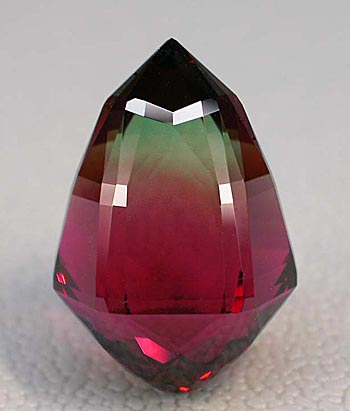 |
| A stunning bi-color tourmaline acorn, cut by Pala International’s Meg Berry. This stone won an AGTA Cutting Edge award in 1995. Photo: Wimon Manorotkul |
Introduction/Name. Tourmaline is the name for a group of related mineral species. In gemological practice, individual species names are not used. Instead all are simply termed “tourmaline.” The name is derived from the Sinhalese word “tourmali,” which means “mixed parcel.”
Color. Color is king for Tourmaline, which is found in more hues, shades and nuances than any other gem. Indeed, not only does tourmaline come in every possible color, but some tourmalines have more than one color in the same stone. Here are a few of the more important varieties:
- Rubellite – red
- Indicolite – blue
- Chrome– intense green colored by chromium/vanadium
- Bi-Color – tourmalines which display two or more colors in the same stone
- Watermelon – Bi-color tourmalines which show a green skin and a red core; these are often cut as slices
- Canary – bright yellow tourmaline from Malawi
- Paraíba– intense blue to green from Paraíba, Brazil, colored by copper
- Cat's Eye – chatoyant tourmaline in a variety of colors
- Color-Change – changes from green in daylight to red in incandescent light
Other varieties are sold simply with a color prefix, as in “pink tourmaline.” As with most gems, the color should be as intense as possible, not too dark or too light.
One of the more distinctive features of tourmaline is its strong pleochroism, with the ordinary ray color (the color seen parallel to the c-axis) being deeper than that of the extraordinary ray. In some varieties, this can easily be seen in the face-up position.
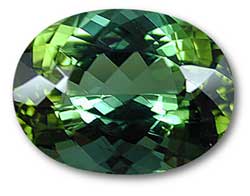 |
The effects of pleochroism can clearly be seen in this oval green tourmaline. Along the vertical axis, a bluish green color is seen, while along the horizontal axis, the color is yellowish green. This is a product of the doubly refractive nature of tourmaline. Photo: Wimon Manorotkul |
Lighting. The proper lighting conditions for tourmaline will depend on the color variety. Reds, oranges and yellows generally look best under incandescent light, while greens, blues and violets appear prettier under daylight. When buying any gem, it is always a good idea to examine it under a variety of light sources, to eliminate future surprises.
Clarity. Different varieties of tourmaline tend to have different clarities. Thus while large clean tourmalines in the blue and blue-green colors are available, almost all red and pink tourmalines will show eye-visible inclusions. The most common inclusions in tourmaline are fractures and liquid-filled healed fractures. Needle inclusions are also common.
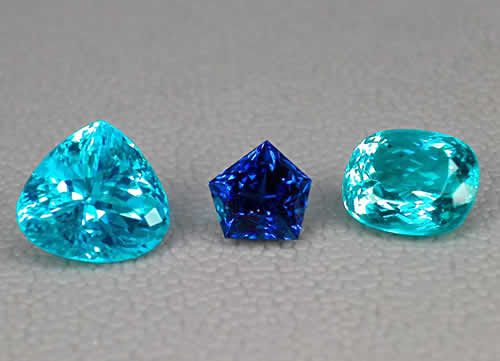 |
| This suite of electric Paraíba tourmalines shows just why the stone has set the gem world afire. Stones such as this typically sell for tens of thousands of dollars per carat. Photo: Wimon Manorotkul |
Cut. The cuts used on tourmaline are as varied as the color. Due to its strong pleochroism, darker tourmalines are cut to display the lighter of the two pleochroic colors. This means orienting the c-axis of the crystal parallel to the table facet. Gems cut with this orientation are often rectangles and rectangular emerald cuts because of the elongated nature of tourmaline crystals.
Tourmalines of lighter color are typically oriented with the table facet perpendicular to the c-axis, to display the richest color possible. Thus they are often cut as rounds, triangles, trillions and ovals. A quick glance at the tourmaline suite shows this.
In addition to faceted stones, cabochon-cut tourmalines are often seen.
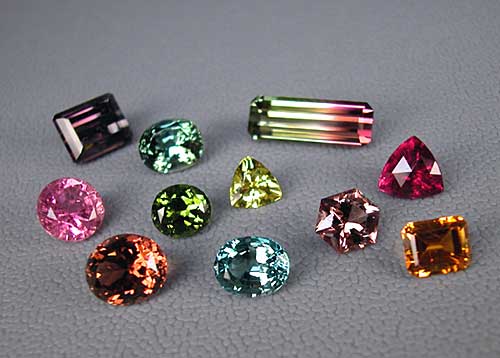 |
| A suite of tourmalines from Pala International illustrates the tremendous variety within this gem family. Photo: Wimon Manorotkul |
Prices. The prices of tourmaline vary tremendously, depending on the variety and quality. Most expensive are the Paraíba tourmalines, which may reach tens of thousands of dollars per carat. Chrome tourmalines, rubellites and fine indicolites and bi-colors may sell for as much as $1000/ct. or more. Other varieties are available for prices between $50–750/ct., depending on the richness of the color.
Stone Sizes. Paraíba tourmalines are extremely rare in faceted stones above 2 cts. Fine Paraíba above 5 carats can be considered world-class pieces. Most stones tend to be less than 1 ct. Chrome tourmalines of quality are rare in sizes above 10 cts., as are rubellites.
Sources. Tourmaline is a pegmatite mineral and so is mined from the world’s great pegmatite districts. Foremost is Brazil, but fine tourmalines are also found in San Diego County, including the famous Pala pegmatite district, and Maine. The East African countries of Kenya, Tanzania, Mozambique and Madagascar have also produced fine tourmaline in the past. Beautiful yellow “canary” tourmalines come from Malawi, while extremely fine rubellites and blue-green tourmalines are found in Nigeria. Afghanistan, Sri Lanka and Burma also produce gem tourmalines on occasion.
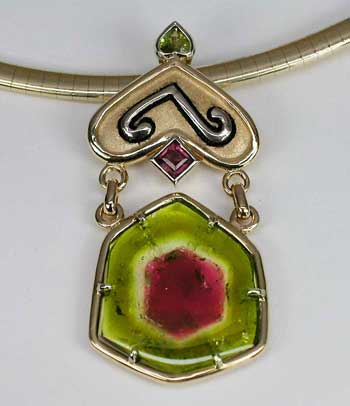 |
| This watermelon tourmaline pendant from California’s Himalaya Mine is a wonderful example of the variety. Jewelry: The Collector; Photo: Wimon Manorotkul |
Enhancements. Like the color itself, the enhancement possibilities for tourmaline are wide in variety. The resulting stones are stable under normal wearing conditions and completely safe. Heat treatments are used in some instances, while irradiation is used in others. Occasionally tourmaline is oiled to hide the visibility of fractures and other surface-reaching fissures.
Imitations. Tourmaline has never been synthesized, but a number of imitations exist, including natural stones and man-made imitations such as glass.
Lore. The following story comes from “San Diego’s Gem Casket” by Richard Keene, an article originally published in The Pacific Monthly, March 1906.
There is a legend told about the tourmaline. Once upon a time there lived a hideous evil spirit, who being himself so ugly, was thrown into a terrible rage on seeing anything beautiful. One day while sitting on the edge of the cave in which he lived, he saw a rainbow in the sky above him, and on seeing its varied and beautiful colors, his anger knew no bounds. By the use of an evil spell he captured the many-hued rainbow and carried it into the dark fissure, where it remained unto this day, and prospectors finding pieces of the broken rainbow, crushed by this evil spirit in his fury, named them tourmaline.
| Chrome tourmaline from Tanzania features an intense, almost emerald green color. Photo: Wimon Manorotkul | 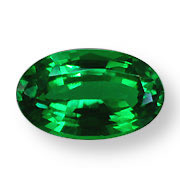 |
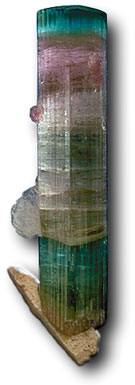 |
| The wide variety of colors possible in tourmaline is illustrated by this stunning crystal from California’s Himalaya Mine. |
Properties of Tourmaline
| Tourmaline (a mineral group) | |
| Composition | Tourmaline is one of the most complex of all mineral groups, and includes the following species:
In summary, tourmaline is a complex aluminum boro-silicate, with heavy emphasis on the “complex.” One pundit likened it more to a medieval alchemist’s brew than a respectable mineral species. And a glance at the above formulae would bear that out. |
| Hardness (Mohs) | 7 to 7.5 |
| Specific Gravity | 3.06 (+ 0.20; - 0.06) |
| Refractive Index | 1.624–1.644 (0.18–0.40; usually 0.20, may be greater in dark stones); doubly refractive, uniaxial negative |
| Crystal System | Hexagonal-trigonal |
| Colors | Any and all. Tourmaline occurs in more colors than any other gem. Some colors have specific variety names, including:
|
| Pleochroism | Strongly dichroic with the ordinary ray having a darker color |
| Dispersion | 0.017 |
| Phenomena | Cat's eye tourmalines are common. Color-change chrome tourmalines, which change from green to red, are occasionally found. |
| Handling | Ultrasonic: generally safe, but risky if the gem contains liquid inclusions Steamer: not safe The best way to care for tourmaline is to clean it with warm, soapy water. Avoid exposing it to heat or acids. |
| Enhancements | A variety of enhancements are regularly applied to tourmaline, depending on the source and variety. These include heat, irradiation, and oiling. |
| Synthetic available? | No |
Further reading
For more on tourmaline, see: